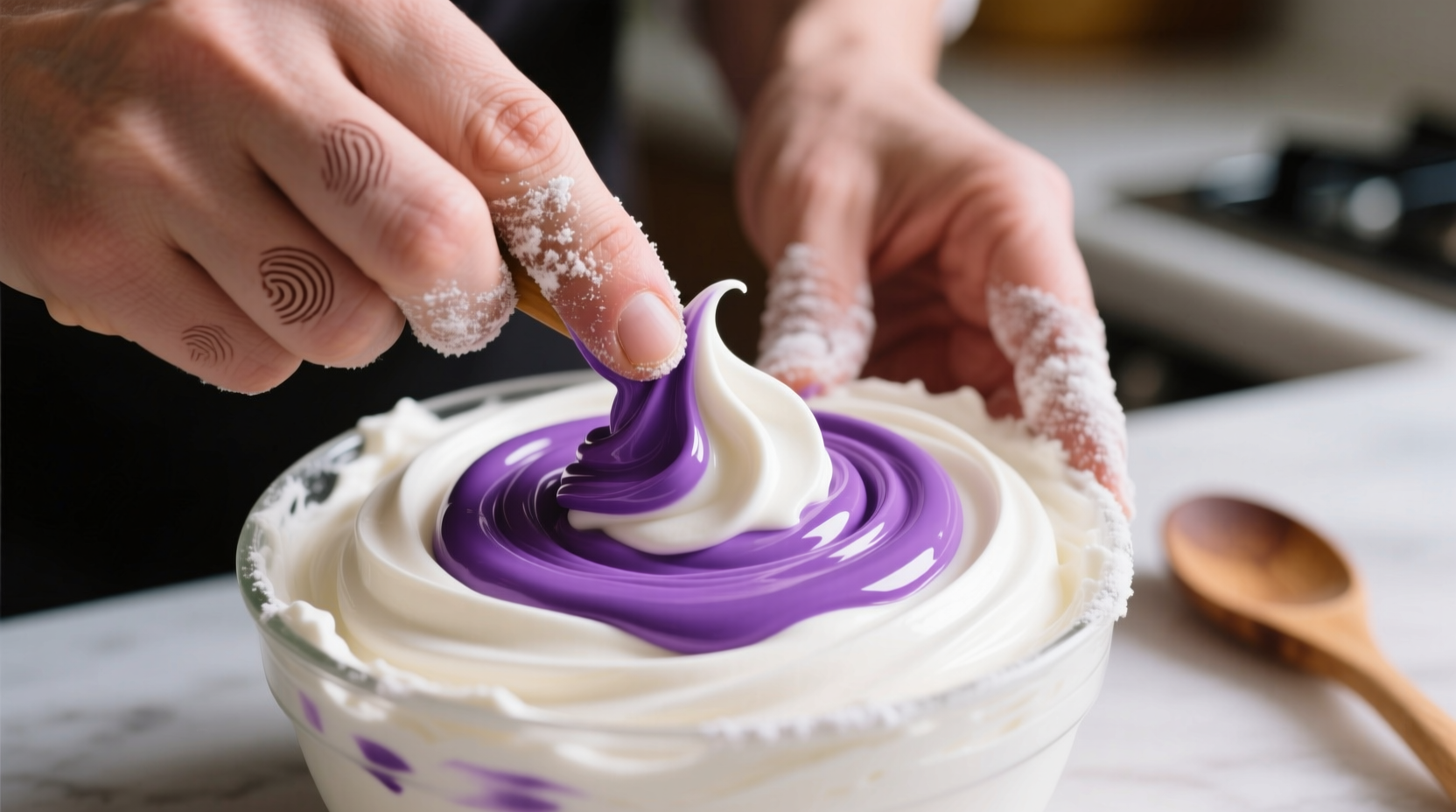Creating the perfect purple shade for your baking or decorating project doesn't require special ingredients—just understanding basic color mixing principles and having the right technique. Whether you're preparing birthday cakes, holiday cookies, or special occasion treats, getting that vibrant purple hue can elevate your creations from ordinary to extraordinary.
The Science Behind Perfect Purple Food Coloring
Purple sits between red and blue on the color wheel, making it a secondary color created by combining these two primary colors. Food coloring behaves differently than paint or dyes due to its concentrated formula and interaction with various food bases.
Unlike art pigments where equal parts create perfect purple, food coloring requires careful calibration because:
- Most red food colors have orange undertones that can create brownish hues
- Blue food coloring is often more potent than red
- Food bases (like frosting or batter) have their own color that affects the final result
Step-by-Step Purple Mixing Process
Follow this professional technique used by cake decorators to achieve consistent purple results every time:
- Start with a clean base - Use white frosting, icing, or batter for most predictable results
- Prepare your tools - Have toothpicks, small bowls, and separate droppers ready
- Begin with the blue - Add 3 drops of blue food coloring to your base first (blue is typically more potent)
- Add red gradually - Incorporate 5 drops of red food coloring, mixing thoroughly after each addition
- Test and adjust - Place a small amount on white paper to see true color (food coloring appears darker in containers)
- Refine your shade - Add single drops of either color until you reach your target purple

Purple Color Ratio Reference Guide
| Desired Shade | Blue Drops | Red Drops | Additional Tips |
|---|---|---|---|
| Lavender | 2 | 3 | Add 1 drop violet if available for authentic lavender |
| Standard Purple | 5 | 5 | Mix thoroughly and let rest 15 minutes for true color |
| Violet | 6 | 4 | Use gel coloring for more intense violet results |
| Eggplant | 5 | 6 | Add 1/2 drop black or brown for deeper effect |
Troubleshooting Common Purple Problems
Even with proper ratios, you might encounter these common issues when making purple food coloring:
When Purple Turns Brown
This happens when you've added too much red, which contains orange pigments. To fix:
- Add small amounts of blue (1 drop at a time)
- If too far gone, start with a new base and use a 6:4 blue-to-red ratio
- Consider using a violet-based red coloring instead of standard red
When Purple Looks Too Blue
If your mixture appears more blue than purple:
- Add red in single drops, mixing thoroughly after each addition
- Use a warm-toned red rather than cool-toned red
- Remember that purple will deepen as it sets (wait 15-30 minutes before final adjustments)
Context-Specific Purple Mixing Guidelines
Different applications require different approaches to achieve perfect purple. Understanding these context boundaries will help you get consistent results:
- Frosting/Icing - Requires more coloring than liquids; gel colors work better than liquid for vibrant results without altering texture
- Cake Batter - Needs approximately 25% more coloring than frosting due to the larger volume and chemical reactions during baking
- Buttercream - Achieves deepest colors; let colored buttercream rest 4-6 hours for true color development
- Whipped Cream - Use minimal coloring as it dilutes quickly; violet food coloring works better than mixing red and blue
Advanced Purple Techniques for Professional Results
Take your purple food coloring skills to the next level with these professional techniques:
Creating Layered Purple Effects
For ombre cakes or galaxy-themed desserts, prepare three shades:
- Light: 2 blue + 3 red drops
- Medium: 4 blue + 4 red drops
- Dark: 6 blue + 5 red drops + 1/2 black
Color Resting Time Matters
Food coloring continues to develop for several hours after mixing. For true color assessment:
- Wait at least 15 minutes before final adjustments
- For buttercream, allow 4-6 hours for color to fully develop
- Store colored items in airtight containers to prevent color oxidation
Why Brand Matters in Purple Food Coloring
Not all food colorings produce the same results. Research from the FDA Food Colors Database shows significant variation in color intensity between brands. Professional bakers often prefer:
- Gel-based colors for concentrated pigments without liquid dilution
- Violet-specific colors instead of mixing red and blue
- Brands with minimal orange undertones in their red coloring
According to culinary research from the University of Illinois Food Science Department, the chemical composition of food coloring affects how colors interact—some red dyes contain tartrazine that reacts differently with blue coloring agents.
Practical Purple Applications
Now that you've mastered the basics, try these popular purple applications:
- Birthday Cakes - Use medium purple (5:5 ratio) for vibrant birthday cakes that photograph beautifully
- Holiday Cookies - For Easter or Valentine's Day, create soft lavender with 3:4 blue-to-red ratio
- Special Occasion Desserts - Deep eggplant purple (5:6 ratio) works beautifully for elegant dinner party desserts
- Themed Parties - Adjust ratios to match specific character themes (lighter for children's parties, deeper for adult events)
Troubleshooting Guide for Specific Purple Challenges
When working with different food bases, you'll encounter unique challenges:
- With Chocolate Bases - Chocolate's brown color requires significantly more purple coloring; start with triple the standard amount
- In Clear Liquids - Beverages need less coloring than solids; use 1-2 drops total for 8oz liquid
- For Fondant - Knead coloring gradually into small portions before combining; fondant requires the most coloring of any application
- When Baking - Colors often fade during baking; increase purple coloring by 30-50% for baked goods











 浙公网安备
33010002000092号
浙公网安备
33010002000092号 浙B2-20120091-4
浙B2-20120091-4